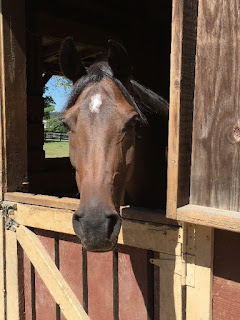Anyone above a certain
age will remember the classic 1960s television show, “Mr. Ed.” The palomino spoke only to his owner, Wilbur
and episodes focused on the trouble-making antics of Mr. Ed.
 |
| "A horse is a horse, of course, of course, And no one can talk to a horse, of course, Unless, of course, the horse, of course, is the famous Mr. Ed" |
Deja is the perfect example
of a horse that understands the spoken word.
Like Queenie, Deja came from Days End Farm Horse Rescue (DEFHR). When she arrived at DEFHR, Deja had never
been handled by any person. Her owner
had turned Deja and a large number of other horses out in a field to fend for
themselves. Phoebe fell hopelessly in
love with Deja after she was rescued by DEFHR and adopted her despite the horse’s nearly feral nature.
 |
| Deja |
Working with an excellent
trainer, Phoebe spent 18 months doing groundwork with Deja and teaching her
voice commands before riding her for the first time. At last count, Deja understands and responds
to almost 30 words.
I trained Queenie using
many of the same voice commands which has worked out well in terms of herd
management. For example, if I want to
bring the horses in from the front pasture, I walk out in the field and say
“in” while pointing toward the barn. I
may have to say it a few times but Deja and Queenie will both head for the
barn. The other two horses inevitably
follow. Similarly, if the horses are in
the pasture near the barn, I only need to say “in,” and Queenie and Deja will
go in their stalls. Both horses
understand that a tap on their leg and the word “foot,” means that they should
lift their hoof for cleaning.
Queenie and Deja also
understand “kiss.”
I realized how critical
verbal cues can be when a little Mustang named Thunder came to my farm two
years ago. Laury acquired Thunder after
Ace, her quarter horse, died of cancer.
Thunder’s previous owner bought him almost 20 years ago in Arizona. Thunder was trained by the Navajo Nation and had
been part of a herd of Western trail riding horses on a ranch in Bumblebee,
Arizona.
 |
| Thunder |
 |
| Thunder's "N" on his left shoulder is a Navajo Nation brand |
 |
| According to my research, this brand could represent an individual tribe member or a ranch. |
 |
| Thunder is fearless out on the trail |
But Thunder was truly
terrified of anything and everything on the farm. When I put his feed bucket down, he stood at
least six feet away until I returned to the barn. Even then, he would keep an eye on me in case
I suddenly decided to move back toward him.
He was equally nervous if I stood near a gate after opening it to let
the horses into a different pasture. He
would stand frozen, staring at me until he thought it was safe and then he
would gallop through the gate. It seemed
as though at some point in his life, he may have been smacked as he went
through a gate.
Thunder’s previous owner
did not believe in putting fly masks or blankets on his horses. I take the opposite approach for the horses’
comfort and health. The tiny flies that gather in a horse’s
eyes and feed on the moisture there, for example, may carry infectious
conjunctivitis, which causes red, swollen and itchy eyes. Blanketing in temperatures below 40 degrees is
more important for elderly horses like Queenie (at least 23 years old) and Thunder (26
years old).
 |
| Queenie modeling the latest in fly masks |
My
heart ached to see the fear in Thunder’s eyes anytime I came near him in those
first few weeks. I was determined to
work with him so he would be less fearful.
And here’s where talking and verbal cues come in. Consistently using the cues meant Thunder
learned exactly what to expect when I said “ears,” "foot" or any of the other
cues.
 |
| Talking to Thunder |
I had
attended a seminar in which Linda Tellington-Jones demonstrated her well-known
TTouch method. Tellington-Jones developed the Tellington Method and TTouch
as a form of communication between horse and human. The method uses circular movements of the
fingers and hands in different areas of the horse’s body to increase relaxation
and decrease anxiety.
 |
| Linda Tellington-Jones demonstrating TTouch |
I
practiced my TTouch skills on Thunder and he LOVED it. He would start out with his head up and eyes
wide with fear. Within 10 minutes, his
head would drop and his eyes would half close.
For a few minutes at least, I could TTouch Thunder’s fears away.
I
confess that I also liberally used treats to help calm Thunder’s nerves. Some trainers strongly discourage training
horses with treats for fear that they will become aggressive in their search
for food. And it is true that there is
nothing worse than a pushy 1,000-pound animal who thinks you MUST feed him. But this blog post (thesoulofahorse.com/blog/training-with-treats-stepping-out-of-the-box/)
gives an excellent argument for the use of treats because they “enhance
communication.”
With Thunder, treats helped him learn that he had nothing to fear when I walked up to him. It was also a good way to reward him for patiently accepting something he was afraid of, such as the fly mask or blanket.
It took
more than a year, but finally Thunder started walking up to me when I called
him. I felt like I had conquered
Everest! Thunder is still a work in
progress. Like Wilbur, I will continue
to talk to Thunder and the other horses.
And they might even answer me in their own way with the occasional soft nicker.



No comments:
Post a Comment